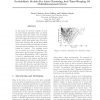100
click to vote
UAI
2003
15 years 2 months ago
2003
We formulate a principle for classification with the knowledge of the marginal distribution over the data points (unlabeled data). The principle is cast in terms of Tikhonov styl...
112
Voted
UAI
2003
15 years 2 months ago
2003
Currently, there is renewed interest in the problem, raised by Shafer in 1985, of updating probabilities when observations are incomplete (or setvalued). This is a fundamental pro...
UAI
2003
15 years 2 months ago
2003
In this paper we present a family of models and learning algorithms that can simultaneously align and cluster sets of multidimensional curves measured on a discrete time grid. Our...
UAI
2003
15 years 2 months ago
2003
In this paper, we provide new complexity results for algorithms that learn discrete-variable Bayesian networks from data. Our results apply whenever the learning algorithm uses a ...
UAI
2003
15 years 2 months ago
2003
Decentralized resource allocation is a key problem for large-scale autonomic (or self-managing) computing systems. Motivated by a data center scenario, we explore efficient techn...
UAI
2003
15 years 2 months ago
2003
We look at the problem of revising fuzzy belief bases, i.e., belief base revision in which both formulas in the base as well as revision-input formulas can come attached with varyi...
UAI
2003
15 years 2 months ago
2003
We investigate the use of probabilistic models and cost-benefit analyses to guide the operation of a Web-based question-answering system. We first provide an overview of research ...
132
Voted
UAI
2003
15 years 2 months ago
2003
The Hierarchical Mixture of Experts (HME) is a well-known tree-structured model for regression and classification, based on soft probabilistic splits of the input space. In its o...
106
click to vote
UAI
2003
15 years 2 months ago
2003
This paper introduces improved methodology to triangulate dynamic graphical models and dynamic Bayesian networks (DBNs). In this approach, a standard DBN template can be modified...
UAI
2003
15 years 2 months ago
2003
The paper studies empirically the time-space trade-off between sampling and inference in the cutset sampling algorithm. The algorithm samples over a subset of nodes in a Bayesian ...

